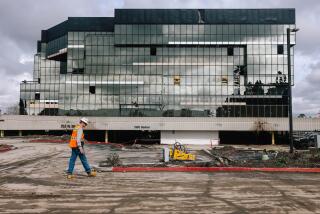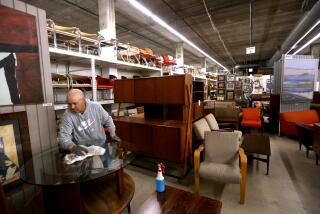In the Boom-or-Bust Crane Game, Things Are Looking Up
- Share via
A forest of spindly construction cranes stands beside the San Diego Freeway, witness to Orange County’s first major high-rise building boom.
Those who lease and operate the huge mechanical hoists consider Orange County’s fast-developing urban corridor, which stretches through Costa Mesa, Newport Beach and Irvine, one of Southern California’s “hot spots.”
“Business is good, and it looks like there is no slowdown in the future,” said Bill Clarke, owner of Clarke Crane Service, a small crane rental company in Cypress. Crane orders began picking up in March, Clarke said, and in more recent months all six of his rigs have been leased at once. At times this summer, he said, he has been obliged to sublease rigs from other construction equipment companies to meet his customers’ demand.
In high-rise construction, cranes are used to lift to upper stories everything from steel beams to panes of glass and air-conditioning equipment. They come in two basic forms: “truck cranes” on wheels that can move around a building, using long-armed booms with hooks on the end to lift multi-ton loads to their destination, and stationary “tower cranes” that are erected inside or beside the building under construction and have a rotating, T-shaped boom.
While some building contractors own cranes, the vast majority of cranes are owned and maintained by leasing companies, which transfer them from job to job around the country. Contractors are deterred from owning cranes because of cost.
Tower cranes sell for $500,000 to $3 million, depending on size, while mobile cranes usually are priced between $750,000 and $1 million.
So contractors generally prefer to lease cranes just when they need them at rates of up to $385 an hour for the mobile variety and $10,000 to $15,000 a month for a tower crane, which also entails an installation cost of about $75,000.
Feast or Famine
The crane business, as any other associated with the construction industry, is usually in a state of feast or famine, said Clarke: “1983 was a very slow year, the slowest I’ve ever seen, and (1985) is one of the best I’ve ever seen.”
“There must be 25 to 30 rigs in the (John Wayne) airport area,” said Robert Jackson, who operates one of the taller cranes, one that’s putting the travertine marble facing on twin 12-story office buildings under construction next to the new Hilton Hotel on Jamboree Boulevard.
As a boy Jackson loved tinkering with toy trucks and electric trains. Now he loves making the 220-foot boom of his crane swing smoothly and precisely, carrying cargoes weighing up to 80 tons. Crane operators, he says, are envied on construction sites. He takes pride in operating his powerful rig that he figures is worth more than $1 million and which his employer, Clarke Crane Service, rents to contractors at the rate of $220 an hour.
At 34, Jackson has been operating cranes for about 13 years and considers himself a pro. For his experience and expertise he earns $40 an hour.
“Operating a rig is like being a professional ball player; everybody wants to do it and not everybody can,” he said. “Everything works on depth perception.”
Running a crane also challenges an operator’s coordination, he explained. Seated in the crane’s cab on the ground, he controls the reach of the boom and throttle with his feet while working with his hands the levers that rotate the crane and hoist the load.
Hoisting the Marble
Wednesday morning, 2,000-pound chunks of travertine marble were attached to the hook of Jackson’s hydraulic crane. It was Jackson’s job to hoist the marble pieces 162 feet in the air to the 12th floor of an office structure, where holes in the marble had to be fitted onto spikes and secured. When each rectangular piece was positioned within a foot of its target, two construction workers perched on the steel skeleton of the building coached Jackson the rest of the way over an intercom radio.
The danger, Jackson said, is always to the crane operator’s co-workers, who could be knocked to their deaths by a false swing. “You learn to be smooth and then you learn speed,” he said.
More to Read
Sign up for Essential California
The most important California stories and recommendations in your inbox every morning.
You may occasionally receive promotional content from the Los Angeles Times.













